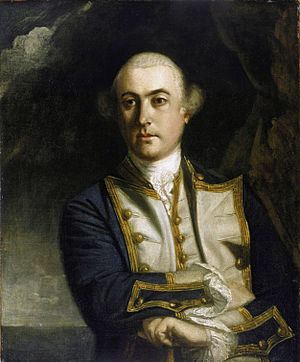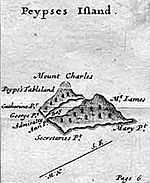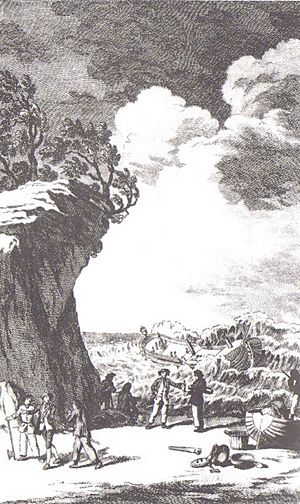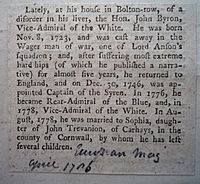John Byron facts for kids
Quick facts for kids
Vice-Admiral
The Honourable John Byron
|
|
|---|---|

Captain the Honourable John Byron, Joshua Reynolds, 1759
|
|
| Born | 8 November 1723 |
| Died | 10 April 1786 (aged 62) London, England |
| Buried |
Church of St Mary the Virgin, Twickenham
|
| Allegiance | |
| Service/ |
|
| Years of service | 1731–1786 |
| Rank | Vice-Admiral |
| Commands held | HMS Siren HMS Dolphin Leeward Islands Station |
| Battles/wars | |
Vice-Admiral John Byron (born November 8, 1723 – died April 1, 1786) was a British Royal Navy officer and explorer. People called him "Foul-Weather Jack" because he often ran into bad storms at sea.
When he was a young sailor, he joined George Anson's trip around the world. However, Byron's ship, HMS Wager, was shipwrecked off the coast of Chile. He managed to return to England. Later, he became the governor of Newfoundland. He also sailed around the world as a commodore from 1764 to 1766. John Byron fought in important battles during the Seven Years' War and the American Revolution. He rose to the rank of Vice Admiral before he passed away in 1786.
His grandsons include the famous poet Lord Byron and George Anson Byron, who was also an admiral and explorer.
John Byron was the second son of William Byron, 4th Baron Byron. He studied at Westminster School. At just 14 years old, he joined the Royal Navy. His first voyage was on HMS Romney between 1738 and 1740.
Anson's journey around the world
In 1740, John Byron joined George Anson's voyage around the world. Byron was a midshipman on one of the ships in the fleet.
On May 14, 1741, Byron's ship, HMS Wager, was shipwrecked. It crashed on the coast of Chile, on an island now called Wager Island. Byron was one of the survivors. The group of survivors decided to split up. Some tried to sail to Rio de Janeiro on the Atlantic coast. John Byron and the ship's captain decided to sail north along the Spanish colonial coast.
Captain Cheap and 19 men, including John Byron, tried to row up the coast. They faced constant rain, strong headwinds, and dangerous waves. One night, a boat was swept out to sea, and one of the two men with it drowned. With fewer boats, they had to leave four marines behind. When they returned for the marines, they were gone. The group then went back to Wager Island in February 1742. There were now 13 people left.
A local leader named Martín Olleta from the Chono people helped guide the men. They traveled up the coast towards Spanish settlements on Chiloé Island. Two more men died on this journey. Six sailors then left in a boat and were never seen again. Captain Cheap, Byron, and two others were left behind. Olleta agreed to guide the remaining four by canoe. They eventually reached Spanish territory and were taken prisoner. The Spanish treated them well. They were taken to Santiago, the capital, and later released.
Byron and the other three men stayed in Santiago until late 1744. They were offered a trip on a French ship going to Spain. Three of them took this offer. After being held in prison in Spain, they finally reached Britain in 1746.
Byron wrote a book about his adventures called The Narrative of the Honourable John Byron (1768). It told the story of the shipwreck and the mutiny that happened afterward. His book was very popular and was printed many times.
In December 1746, Byron was made captain of HMS Siren.
Seven Years' War
In 1760, during the Seven Years' War, Byron led a group of ships. Their mission was to destroy the forts at Louisbourg, Quebec. The British had captured Louisbourg two years earlier. They wanted to make sure the French could not use it again in Canada. In July of that year, Byron defeated a French fleet. This fleet was trying to help New France at the Battle of Restigouche.
Commodore, governor, and vice admiral
In 1764, the British Navy decided they needed a permanent base near South America. This base would help resupply ships going into the Pacific Ocean around Cape Horn. Captain Byron was chosen to find a good island for this base in the South Atlantic. Spain controlled the South American mainland and didn't want Britain expanding there. To hide Byron's real mission, it was announced he was going to be the new Navy Commander in the East Indies.
Byron set sail in June 1764. He commanded the 24-gun frigate HMS Dolphin and the 16-gun sloop HMS Tamar.

Byron's two ships crossed the Atlantic in late 1764. They slowly sailed down the South American coast. The Navy had told Byron to first look for Pepys Island. This island was supposedly discovered off the Patagonian coast in 1683. Byron reached the island's reported location in January 1765. However, there was no island there, and they quickly stopped looking. On February 5, Byron reached Port Desire in Patagonia. Here, he restocked his ships from a supply vessel.
Between June 1764 and May 1766, Byron completed his own trip around the world. He was the captain of HMS Dolphin. This was the first time someone had sailed around the world in less than two years. His actions almost caused a war between Great Britain and Spain. Both countries had navies ready to fight over who owned the Falkland Islands. Later, Byron found islands and people in the Tuamotus and Tokelau Islands. He also visited Nikunau in the southern Gilbert Islands and Tinian in the Northern Marianas Islands.
In 1769, he became the governor of Newfoundland, Canada. He held this job for three years.
He was promoted to rear admiral on March 31, 1775. In 1779, he was the Commander-in-chief of the Leeward Islands Station during the American War of Independence. Byron was badly hurt in a storm on his way to the West Indies. He then unsuccessfully attacked a French fleet at the Battle of Grenada in July 1779. After this, he resigned his position and went back to England. He had poor health for the rest of his life.
Byron was briefly the Commander-in-Chief, North American Station starting October 1, 1779. He was made vice admiral in September 1780.
Family
On September 8, 1748, John Byron married his cousin, Sophia Trevanion. They had two sons and seven daughters:
- Frances Byron (1749–1823)
- Juliana Elizabeth Byron (1754–88)
- Sophia Maria Byron (1755–1821), who was the aunt of the poet George Gordon Byron
- John "Mad Jack" Byron (1757–91), who was the father of the poet George Gordon Byron
- George Anson Byron (1758–93), a navy officer and father of George Anson Byron junior, who was also an admiral and explorer.
- Augusta Barbara Charlotte Byron (1762–1824)
Death and legacy
John Byron passed away on April 1, 1786, at his home in London. He was buried in the Berkeley family tomb in the Church of St Mary the Virgin in Twickenham.
John's life greatly inspired his grandson, the poet George Gordon Byron. Even though they never met, the poet used his grandfather's experiences in his writing. For example, he used the "Narrative" for the shipwreck scene in his poem, Don Juan. The poet also felt a connection to his grandfather's difficult life. He wrote that his grandfather "had no rest at sea, nor I on shore."
In fiction
John Byron's adventures during the Anson voyage are the basis for the novel The Unknown Shore by Patrick O'Brian. This book closely follows Byron's own account.
In The Dark Design by Philip José Farmer, John Byron is a crewmember on a schooner called The Razzle Dazzle.
See also
 In Spanish: John Byron para niños
In Spanish: John Byron para niños
- Baron Byron
- Cape Byron in Australia, named after Byron
- List of Newfoundland and Labrador lieutenant-governors
- List of people of Newfoundland and Labrador
- European and American voyages of scientific exploration



